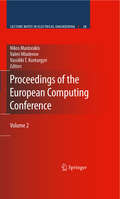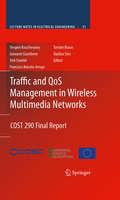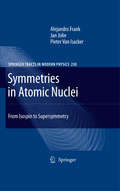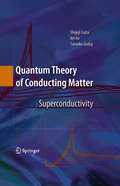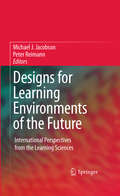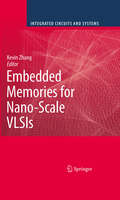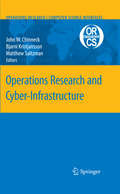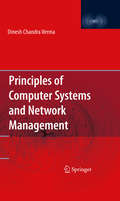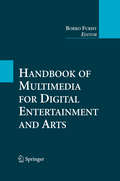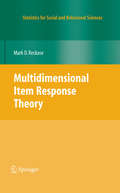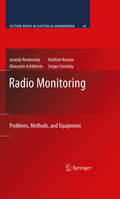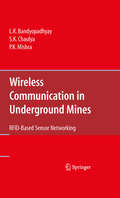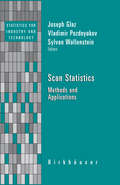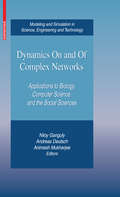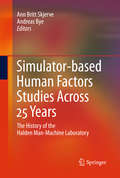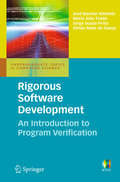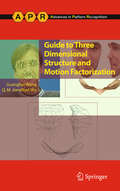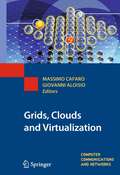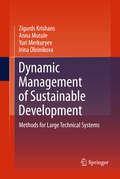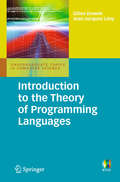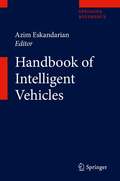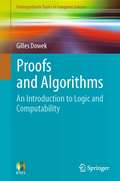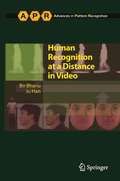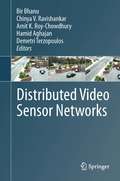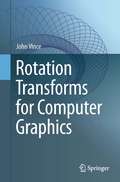- Table View
- List View
Proceedings of the European Computing Conference: Volume 2
by Nikos Mastorakis Vassiliki T. Kontargyri Valeri MladenovThe European Computing Conference offers a unique forum for establishing new collaborations within present or upcoming research projects, exchanging useful ideas, presenting recent research results, participating in discussions and establishing new academic collaborations, linking university with the industry. Engineers and Scientists working on various areas of Systems Theory, Applied Mathematics, Simulation, Numerical and Computational Methods and Parallel Computing present the latest findings, advances, and current trends on a wide range of topics. This proceedings volume will be of interest to students, researchers, and practicing engineers.
Traffic and QoS Management in Wireless Multimedia Networks
by Yevgeni Koucheryavy Torsten Braun Vasilios Siris Dirk Staehle Giovanni Giambene Francisco Barcelo-Arroyo"Traffic and QoS Management in Wireless Multimedia Networks" presents the scientific contributions of the European COST 290 project. Traffic and QoS in wireless networks are addressed from a range of perspectives, including electrical engineering, software development, and networking. This book presents state-of-the-art information, reviews open issues, and suggests directions for future research.
Symmetries in Atomic Nuclei
by Pieter Van Isacker Jan Jolie Alejandro FrankSymmetries in Atomic Nuclei aims to present an overview of recent applications of symmetry to the description of atomic nuclei. Special care is given to a pedagogical introduction of symmetry concepts using simple examples. After a historical overview of the applications of symmetry in nuclear physics, progress in the field during the last decade is reviewed. Special emphasis is put on the introduction of neutron-proton and boson-fermion degrees of freedom. Their combination leads to a supersymmetric description of pairs and quartets of nuclei. Both theoretical aspects and experimental signatures of dynamical (super)symmetries are carefully discussed. Case studies show how these symmetries are displayed by real atomic nuclei which have been studied experimentally using state-of-the art spectroscopy. This book focuses on nuclear structure physics and has been written by active investigators in the field, but its scope is wider and is intended for final-year or post-graduate students and researchers interested in understanding the power and beauty of symmetry methods in physics.
Quantum Theory of Conducting Matter
by Salvador Godoy Shigeji Fujita Kei ItoMajor superconducting properties including zero resistance, Meissner effect, sharp phase change, flux quantization, excitation energy gap, Josephson effects are covered and microscopically explained, using quantum statistical mechanical calculations. First treated are the 2D superconductivity and then the quantum Hall effects. Included are exercise-type problems for each section. Readers can grasp the concepts covered in the book by following the worked-through problems. Bibliographies are included in each chapter and a glossary and list of symbols are given in the beginning of the book. The book is based on the materials taught by S. Fujita for several courses in Quantum Theory of Solids, Advanced Topics in Modern Physics, and Quantum Statistical Mechanics.
Designs for Learning Environments of the Future
by Peter Reimann Michael J. JacobsonFew things are as certain as societal changes--and the pressing need for educators to prepare students with the knowledge and ways of thinking necessary for the challenges in a changing world. In the forward-thinking pages of Designs for Learning Environments of the Future, international teams of researchers present emerging developments and findings in learning sciences and technologies at the infrastructure, curricular, and classroom levels. Focusing on ideas about designing innovative environments for learning in areas such as biology, engineering, genetics, mathematics, and computer science, the book surveys a range of learning technologies being explored around the world--a spectrum as diverse as digital media, computer modeling, and 3D virtual worlds--and addresses challenges arising from their design and use. The editors' holistic perspective frames these innovations as not only discrete technologies but as flexible learning environments that foster student engagement, participation, and collaboration. Contributors describe possibilities for teaching and learning in these and other cutting-edge areas: Working with hypermodels and model-based reasoning Using visual representations in teaching abstract concepts Designing strategies for learning in virtual worlds Supporting net-based collaborative teams Integrating innovative learning technologies into schools Developing personal learning communities Designs for Learning Environments of the Future will enhance the work of a wide range of professionals, including researchers and graduate students in the learning and cognitive sciences, and educators in the physical and social sciences.
Embedded Memories for Nano-Scale VLSIs
by Kevin ZhangThe book provides a comprehensive and in-depth view on the state-of-the-art embedded memory technologies. The book helps practicing engineers grasp key technology attributes and advanced design techniques in nano-scale VLSI design. It also helps them make decisions concerning the right design tradeoffs in real product development. This book first provides an overview on the landscape and trend of embedded memory in various VLSI system designs, including high-performance microprocessor, low-power mobile handheld devices, micro-controllers, and various consumer electronics. It then shows an in-depth view on each different type of embedded memory technology, including high-speed SRAM, ultra-low-voltage and alternative SRAM, embedded DRAM, embedded nonvolatile memory, and emerging or so-called "universal" memories such as FeRAM, MRAM, and PRAM. Each topic covers all the key technology attributes from a product application perspective, ranging from technology scaling challenges to advanced circuit techniques for achieving optimal design tradeoff in performance and power. As VLSI systems become increasingly dependent on on-die memory to provide adequate memory bandwidth for various applications, the book gives readers a broader view of this important field and helps them to achieve their optimal design goals for different applications. This book provides readers a broad knowledge on the entire embedded memory technologies in order to better comprehend the technologies and create optimal memory solutions in real applications.
Operations Research and Cyber-Infrastructure
by Matthew J. Saltzman Bjarni Kristjansson John W. ChinneckOperations Research and Cyber-Infrastructure is the companion volume to the Eleventh INFORMS Computing Society Conference (ICS 2009), held in Charleston, South Carolina, from January 11 to 13, 2009. It includes 24 high-quality refereed research papers. As always, the focus of interest for ICS is the interface between Operations Research and Computer Science, and the papers in this volume reflect that interest. This is naturally an evolving area as computational power increases rapidly while decreasing in cost even more quickly, and the papers included here illustrate the wide range of topics at this interface.
Principles of Computer Systems and Network Management
by Dinesh Chandra VermaSystems Management is emerging as the predominant area for computer science in the enterprise, with studies showing that the bulk (up to 80%) of an enterprise IT budget is spent on management/operational issues and is the largest piece of the expenditure. This textbook provides an overview of the field of computer systems and network management. Systems management courses are being taught in different graduate and undergraduate computer science programs, but there are no good books with a comprehensive overview of the subject. This text book will provide content appropriate for either an undergraduate course (junior or senior year) or a graduate course in systems management.
Handbook of Multimedia for Digital Entertainment and Arts
by Borko FurhtThe advances in computer entertainment, multi-player and online games, technology-enabled art, culture and performance have created a new form of entertainment and art. The success of this new field has influenced the development of the digital entertainment industry and related products/services, which has impacted every aspect of our lives. Handbook of Multimedia for Digital Entertainment and Arts is an edited volume contributed by worldwide experts in the field of the new digital and interactive media, and their applications in entertainment and arts. This handbook covers leading edge media technologies, and the latest research applied to digital entertainment and arts. The main focus of Handbook of Multimedia for Digital Entertainment and Arts targets interactive and online games, edutainment, e-performance, personal broadcasting, innovative technologies for digital arts, digital visual and auditory media, augmented reality, moving media, and other advanced topics. The final chapters of this book present future trends and developments within this explosive field. Handbook of Multimedia for Digital Entertainment and Arts serves as a primary reference for advanced-level students, researchers and professors studying computer science and electrical engineering. With the dramatic growth of interactive digital entertainment and art applications, this handbook is also suitable as a reference for practitioners, programmers, and engineers working in this field.
Multidimensional Item Response Theory
by M. D. ReckaseFirst thorough treatment of multidimensional item response theory Description of methods is supported by numerous practical examples Describes procedures for multidimensional computerized adaptive testing
Radio Monitoring
by Alexander Ashikhmin Vladimir Kozmin Sergey M. Smolskiy Anatoly RembovskyRadio Monitoring: Problems, Methods, and Equipment offers a unified approach to fundamental aspects of Automated Radio Monitoring (ARM). The authors discuss the development, modeling, design, and manufacture of ARM systems. Data from established and recent research are presented and recommendations are made on methods and approaches for solving common problems in ARM. The authors also provide classification and detailed descriptions of modern high-efficient hardware-software ARM equipment, including the equipment for detection, radio direction-finding, parameters measurement and their analysis, and the identification and localization of the electromagnetic field sources. Examples of ARM equipment structure, applications, and software are provided to manage a variety of complicated interference environment in the industrial centers, inside of the buildings, and in the open terrain. This book provides a reference for professionals and researchers interested in deploying ARM technology as a tool for solving problems from radio frequency spectrum usage control.
Wireless Communication in Underground Mines
by P. K. Mishra L. K. Bandyopadhyay S. K. ChaulyaUnderground mines require fool-proof, mine-wide communication systems for smooth functioning of mine production and worker safety. Proper and reliable communication systems not only decrease machine break down time, but more importantly provide immediate transmission of messages from the underground working area to the surface for normal mining operations as well as necessary rescue operations in case of disaster. Therefore, a reliable and effective communication system is an essential requisite for safe working, and maintaining the requisite production and productivity of underground mines. Existing wired communication systems cannot reach parts of complex mines, and are ineffective in many disaster situations. Wireless Communication in Underground Mines focuses on the recent advancement in wireless communication technologies for underground mines and other hazardous areas. This comprehensive book provides a unified foundation of wireless communication systems for transmission of data, voice and video. The book also incorporates intrinsically safe design and development aspects of circuits, which are essential for underground mines and hazardous areas. The book consists of recent wireless communication technologies designed and developed by the authors for underground mines and draws upon their experiences in the fields. Wireless Communication in Underground Mines covers a wide range of the recent practices of wireless communication systems as well as wireless sensor networking, radio frequency identification devices, system specific embedded software, application software, and designing and developing techniques for intrinsic safe circuits.
Scan Statistics
by Vladimir Pozdnyakov Joseph Glaz Sylvan WallensteinScan statistics is currently one of the most active and important areas of research in applied probability and statistics, having applications to a wide variety of fields: archaeology, astronomy, bioinformatics, biosurveillance, molecular biology, genetics, computer science, electrical engineering, geography, material sciences, physics, reconnaissance, reliability and quality control, telecommunication, and epidemiology. Filling a gap in the literature, this self-contained volume brings together a collection of selected chapters illustrating the depth and diversity of theory, methods and applications in the area of scan statistics.
Dynamics On and Of Complex Networks
by Animesh Mukherjee Andreas Deutsch Niloy GangulyThis self-contained book systematically explores the statistical dynamics on and of complex networks having relevance across a large number of scientific disciplines. The theories related to complex networks are increasingly being used by researchers for their usefulness in harnessing the most difficult problems of a particular discipline. The book is a collection of surveys and cutting-edge research contributions exploring the interdisciplinary relationship of dynamics on and of complex networks. Topics covered include complex networks found in nature--genetic pathways, ecological networks, linguistic systems, and social systems--as well as man-made systems such as the World Wide Web and peer-to-peer networks. The contributed chapters in this volume are intended to promote cross-fertilization in several research areas, and will be valuable to newcomers in the field, experienced researchers, practitioners, and graduate students interested in systems exhibiting an underlying complex network structure in disciplines such as computer science, biology, statistical physics, nonlinear dynamics, linguistics, and the social sciences.
Simulator-based Human Factors Studies Across 25 Years
by Ann Britt Skjerve Andreas ByeThe Halden Man-Machine Laboratory (HAMMLAB) has been at the heart of human factors research at the OECD Halden Reactor Project (HRP). The HRP is sponsored by a group of national organizations, representing nuclear power plant regulators, utilities, and research institutions. The HRP is hosted by the Institute for Energy Technology (IFE) in Halden, Norway. HAMMLAB comprises three full-scale nuclear power plant control room research simulators. The simulator studies performed in HAMMLAB have traditionally been experimental in nature. In a simulator it is possible to study events as they unfold in real time, in a highly realistic operational environment under partially controlled conditions. This means that a wide range of human factors issues, which would be impossible or highly impracticable to study in real-life settings, can thus be addressed in HAMMLAB. Simulator-based Human Factors Studies Across 25 Years celebrates the twenty-fifth anniversary of HAMMLAB by reviewing the human factors studies performed in HAMMLAB across this time-span. A range of human factors issues have been addressed, including: * human-system interfaces; * alarm systems; * computerized procedures; * human-automation interaction; * staffing, teamwork and human reliability. The aim of HAMMLAB studies has always been the same: to generate knowledge for solving current and future challenges in nuclear power plant operation to contribute to safety. The outcomes of HAMMLAB studies have been used to support design and assessment of nuclear power plant control rooms.
Rigorous Software Development
by Maria João Frade Jorge Sousa Pinto José Bacelar Almeida Simão Melo de SousaThe use of mathematical methods in the development of software is essential when reliable systems are sought; in particular they are now strongly recommended by the official norms adopted in the production of critical software. Program Verification is the area of computer science that studies mathematical methods for checking that a program conforms to its specification. This text is a self-contained introduction to program verification using logic-based methods, presented in the broader context of formal methods for software engineering. The idea of specifying the behaviour of individual software components by attaching contracts to them is now a widely followed approach in program development, which has given rise notably to the development of a number of behavioural interface specification languages and program verification tools. A foundation for the static verification of programs based on contract-annotated routines is laid out in the book. These can be independently verified, which provides a modular approach to the verification of software. The text assumes only basic knowledge of standard mathematical concepts that should be familiar to any computer science student. It includes a self-contained introduction to propositional logic and first-order reasoning with theories, followed by a study of program verification that combines theoretical and practical aspects - from a program logic (a variant of Hoare logic for programs containing user-provided annotations) to the use of a realistic tool for the verification of C programs (annotated using the ACSL specification language), through the generation of verification conditions and the static verification of runtime errors.
Guide to Three Dimensional Structure and Motion Factorization
by Guanghui Wang Jonathan WuThe problem of structure and motion recovery from image sequences is an important theme in computer vision. Considerable progress has been made in this field during the past two decades, resulting in successful applications in robot navigation, augmented reality, industrial inspection, medical image analysis, and digital entertainment, among other areas. However, many of these methods work only for rigid objects and static scenes. The study of non-rigid structure from motion is not only of academic significance, but also has important practical applications in real-world, nonrigid or dynamic scenarios, such as human facial expressions and moving vehicles. This practical guide/reference provides a comprehensive overview of Euclidean structure and motion recovery, with a specific focus on factorization-based algorithms. The book discusses the latest research in this field, including the extension of the factorization algorithm to recover the structure of non-rigid objects, and presents some new algorithms developed by the authors. Readers require no significant knowledge of computer vision, although some background on projective geometry and matrix computation would be beneficial. Topics and features: presents the first systematic study of structure and motion recovery of both rigid and non-rigid objects from images sequences; discusses in depth the theory, techniques, and applications of rigid and non-rigid factorization methods in three dimensional computer vision; examines numerous factorization algorithms, covering affine, perspective and quasi-perspective projection models; provides appendices describing the mathematical principles behind projective geometry, matrix decomposition, least squares, and nonlinear estimation techniques; includes chapter-ending review questions, and a glossary of terms used in the book. This unique text offers practical guidance in real applications and implementations of 3D modeling systems for practitioners in computer vision and pattern recognition, as well as serving as an invaluable source of new algorithms and methodologies for structure and motion recovery for graduate students and researchers.
Grids, Clouds and Virtualization
by Giovanni Aloisio Massimo CafaroResearch into grid computing has been driven by the need to solve large-scale, increasingly complex problems for scientific applications. Yet the applications of grid computing for business and casual users did not begin to emerge until the development of the concept of cloud computing, fueled by advances in virtualization techniques, coupled with the increased availability of ever-greater Internet bandwidth. The appeal of this new paradigm is mainly based on its simplicity, and the affordable price for seamless access to both computational and storage resources. This timely text/reference introduces the fundamental principles and techniques underlying grids, clouds and virtualization technologies, as well as reviewing the latest research and expected future developments in the field. Readers are guided through the key topics by internationally recognized experts, enabling them to develop their understanding of an area likely to play an ever more significant role in coming years. Topics and features: presents contributions from an international selection of experts in the field; provides a thorough introduction and overview of existing technologies in grids, clouds and virtualization, including a brief history of the field; examines the basic requirements for performance isolation of virtual machines on multi-core servers, analyzing a selection of system virtualization technologies; examines both business and scientific applications of grids and clouds, including their use in the life sciences and for high-performance computing; explores cloud building technologies, architectures for enhancing grid infrastructures with cloud computing, and cloud performance; discusses energy aware grids and clouds, workflows on grids and clouds, and cloud and grid programming models. This useful text will enable interested readers to familiarize themselves with the key topics of grids, clouds and virtualization, and to contribute to new advances in the field. Researchers, undergraduate and graduate students, system designers and programmers, and IT policy makers will all benefit from the material covered.
Dynamic Management of Sustainable Development
by Irina Oleinikova Anna Mutule Yuri Merkuryev Zigurds KrishansDynamic management of systems development is a precondition for the realization of sustainable system development. This approach allows for the usage of systems theory methods that take into consideration the interaction of decisions made over time and space. A characteristic feature of this kind of method is that the process of sophisticated object development over time is examined for optimal decision selection. This requires the application of modelling methods that represent properties of the developing objects, high speed calculation methods for the estimation of technical and economic characteristics, as well as effective optimization methods. Dynamic Management of Sustainable Development presents a concise summary of the authors' research in the area of dynamic methods analysis of technical systems development. Along with systematic illustration of mathematical methods, considerable attention is drawn to practical realization and applications. Dynamic Management of Sustainable Development will be helpful for scientists involved in the mathematical modelling of large technical systems development and for engineers working in the area of large technical systems planning.
Introduction to the Theory of Programming Languages
by Jean-Jacques Lévy Gilles DowekThe design and implementation of programming languages, from Fortran and Cobol to Caml and Java, has been one of the key developments in the management of ever more complex computerized systems. Introduction to the Theory of Programming Languages gives the reader the means to discover the tools to think, design, and implement these languages. It proposes a unified vision of the different formalisms that permit definition of a programming language: small steps operational semantics, big steps operational semantics, and denotational semantics, emphasising that all seek to define a relation between three objects: a program, an input value, and an output value. These formalisms are illustrated by presenting the semantics of some typical features of programming languages: functions, recursivity, assignments, records, objects, ... showing that the study of programming languages does not consist of studying languages one after another, but is organized around the features that are present in these various languages. The study of these features leads to the development of evaluators, interpreters and compilers, and also type inference algorithms, for small languages.
Handbook of Intelligent Vehicles
by Azim EskandarianThe Handbook of Intelligent Vehicles provides a complete coverage of the fundamentals, new technologies, and sub-areas essential to the development of intelligent vehicles; it also includes advances made to date, challenges, and future trends. Significant strides in the field have been made to date; however, so far there has been no single book or volume which captures these advances in a comprehensive format, addressing all essential components and subspecialties of intelligent vehicles, as this book does. Since the intended users are engineering practitioners, as well as researchers and graduate students, the book chapters do not only cover fundamentals, methods, and algorithms but also include how software/hardware are implemented, and demonstrate the advances along with their present challenges. Research at both component and systems levels are required to advance the functionality of intelligent vehicles. This volume covers both of these aspects in addition to the fundamentals listed above.
Proofs and Algorithms
by Gilles DowekLogic is a branch of philosophy, mathematics and computer science. It studies the required methods to determine whether a statement is true, such as reasoning and computation. Proofs and Algorithms: Introduction to Logic and Computability is an introduction to the fundamental concepts of contemporary logic - those of a proof, a computable function, a model and a set. It presents a series of results, both positive and negative, - Church's undecidability theorem, Gödel's incompleteness theorem, the theorem asserting the semi-decidability of provability - that have profoundly changed our vision of reasoning, computation, and finally truth itself. Designed for undergraduate students, this book presents all that philosophers, mathematicians and computer scientists should know about logic.
Human Recognition at a Distance in Video
by Bir Bhanu Ju HanMost biometric systems employed for human recognition require physical contact with, or close proximity to, a cooperative subject. Far more challenging is the ability to reliably recognize individuals at a distance, when viewed from an arbitrary angle under real-world environmental conditions. Gait and face data are the two biometrics that can be most easily captured from a distance using a video camera. This comprehensive and logically organized text/reference addresses the fundamental problems associated with gait and face-based human recognition, from color and infrared video data that are acquired from a distance. It examines both model-free and model-based approaches to gait-based human recognition, including newly developed techniques where the both the model and the data (obtained from multiple cameras) are in 3D. In addition, the work considers new video-based techniques for face profile recognition, and for the super-resolution of facial imagery obtained at different angles. Finally, the book investigates integrated systems that detect and fuse both gait and face biometrics from video data. Topics and features: discusses a framework for human gait analysis based on Gait Energy Image, a spatio-temporal gait representation; evaluates the discriminating power of model-based gait features using Bayesian statistical analysis; examines methods for human recognition using 3D gait biometrics, and for moving-human detection using both color and thermal image sequences; describes approaches for the integration face profile and gait biometrics, and for super-resolution of frontal and side-view face images; introduces an objective non-reference quality evaluation algorithm for super-resolved images; presents performance comparisons between different biometrics and different fusion methods for integrating gait and super-resolved face from video. This unique and authoritative text is an invaluable resource for researchers and graduate students of computer vision, pattern recognition and biometrics. The book will also be of great interest to professional engineers of biometric systems.
Distributed Video Sensor Networks
by Bir Bhanu Demetri Terzopoulos Amit K. Roy-Chowdhury Hamid Aghajan Chinya V. RavishankarLarge-scale video networks are of increasing importance in a wide range of applications. However, the development of automated techniques for aggregating and interpreting information from multiple video streams in real-life scenarios is a challenging area of research. Collecting the work of leading researchers from a broad range of disciplines, this timely text/reference offers an in-depth survey of the state of the art in distributed camera networks. The book addresses a broad spectrum of critical issues in this highly interdisciplinary field: current challenges and future directions; video processing and video understanding; simulation, graphics, cognition and video networks; wireless video sensor networks, communications and control; embedded cameras and real-time video analysis; applications of distributed video networks; and educational opportunities and curriculum-development. Topics and features: presents an overview of research in areas of motion analysis, invariants, multiple cameras for detection, object tracking and recognition, and activities in video networks; provides real-world applications of distributed video networks, including force protection, wide area activities, port security, and recognition in night-time environments; describes the challenges in graphics and simulation, covering virtual vision, network security, human activities, cognitive architecture, and displays; examines issues of multimedia networks, registration, control of cameras (in simulations and real networks), localization and bounds on tracking; discusses system aspects of video networks, with chapters on providing testbed environments, data collection on activities, new integrated sensors for airborne sensors, face recognition, and building sentient spaces; investigates educational opportunities and curriculum development from the perspective of computer science and electrical engineering. This unique text will be of great interest to researchers and graduate students of computer vision and pattern recognition, computer graphics and simulation, image processing and embedded systems, and communications, networks and controls. The large number of example applications will also appeal to application engineers.
Rotation Transforms for Computer Graphics
by John VinceRotation transforms are used everywhere in computer graphics from rotating pictures in editing software, to providing an arbitrary view of a 3D virtual environment. Although the former is a trivial operation, the latter can be a challenging task. Rotation Transforms for Computer Graphics covers a wide range of mathematical techniques used for rotating points and frames of reference in the plane and 3D space. It includes many worked examples and over 100 illustrations that make it essential reading for students, academics, researchers and professional practitioners. The book includes introductory chapters on complex numbers, matrices, quaternions and geometric algebra, and further chapters on how these techniques are employed in 2D and 3D computer graphics. In particular, matrix and bivector transforms are developed and evaluated to rotate points in a fixed frame of reference, and vice versa.
